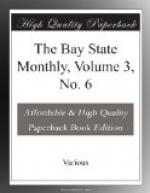The service, equipment, and management of Massachusetts’ railway system is well nigh perfect. Out of 4,100 miles of track in the state, 2,453 are laid with the steel rail. Including the 1,150 engines, 1,554 passenger cars, 394 baggage cars, and 24,418 freight cars, the total cost of railroad equipment in the state has been $178,862,870; from this investment the total earnings in 1884 reached $33,020,816 from which $4,568,274 were paid in dividends. The number of passengers carried were 57,589,200 and 17,258,726 tons of freight moved. One of the most important elements in her system is the Boston and Albany. Its engine service the past year was 5,680,060 miles, the company carried 94,721 through passengers and 8,699,691 way, whose total earnings were $8,148,713.34 and total expenses were $5,785,876.98.
In this connection we would refer to the city and suburban tramway service, which has taken an important part in the development of the state. The total cost of the 336 miles of road and equipment, including 8,987 horses and 1,918 passenger cars is stated at $9,093,935. Number of passengers carried in 1884 was 94,894,259, gross earnings $4,788,096, operating expenses $3,985,617, total available income $924,440. When we consider that the street railway service carried more than 37,000,000 passengers in excess of the steam railways, we realize its importance.
While there are 66,205 more females than males in the state, in the wider distribution of the sexes their equality indicates that it could not happen by chance, and that marriage of one man to one woman was intended.
An authentic estimate of the numerical proportions of the sexes is as follows:—
United States, 983 women to 1,000 men; America, (at large) 980 women to 1,000 men; Scotland, 1,096 women to 1,000 men; Ireland, 1,050 women to 1,000 men; England and Wales, 1,054 women to 1,000 men; France, 1,007 women to 1,000 men; Prussia, 1,030 women to 1,000 men; Greece, 940 women to 1,000 men; Europe, (at large) 1,021 women to 1,000 men; Africa, (estimated) 975 women to 1,000 men; Asia, 940 women to 1,000 men; Australia, 985 women to 1,000 men. In an aggregate of 12,000 men there is a surplus of about 161 women.
Massachusetts has been making notable history ever since 1620, and in picking out here and there a few of the influences which have tended to develope her material resources, we would not be unmindful of those Christian influences which are also a part of her imperishable history.
To the lover of nature, perhaps no state in range of rugged coast and water views blended with mountainous background, can offer more pleasing bits of picturesque scenery. The historic hills of Berkshire and the beautiful Connecticut River, with its 50 miles of sweep through the state, ever hurrying on to the sea, have inspired the tireless shuttles of descriptive imagery to weave some of the finest threads in American thought.




